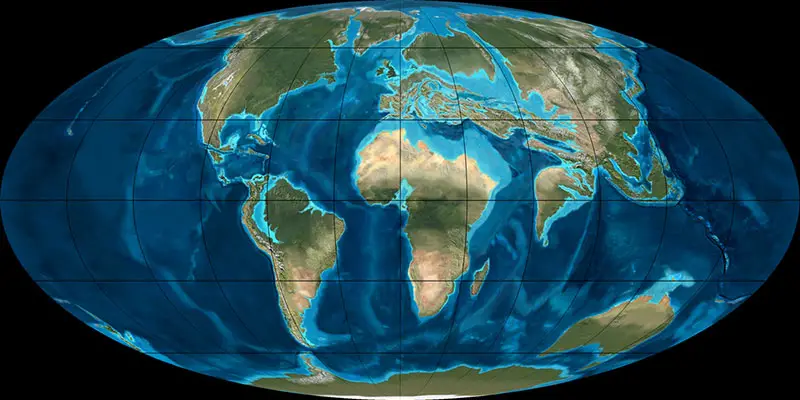†Panobius (Notharctidae)
Panobius ist eine Primatengattung innerhalb der Familie Notharctidae, deren 4 Mitglieder ab dem frühen Paläogen (Eozän) im Ypresium lebten, das vor ungefähr 56 Millionen Jahren begann und bis vor 47,8 Millionen Jahren andauerte. Viele Überreste wurden in Pakistan gefunden.
Panobius ist der Gattungsname dreier ausgestorbener Primaten aus der Unterfamilie Cercamoniinae innerhalb der Familie Notharctidae (Überfamilie Adapoidea).
Panobius ist ein relativ primitiver Cercamoniine, der beispielsweise Donrussellia stärker ähnelt als alle anderen bekannten Adapiformes. Je nach Polarität der Merkmale der Prämolaren könnte Panobius sogar als primitiver als Donrussellia (wenn einfache Prämolaren primitiv sind) interpretiert werden.
Die Adapiformes, die aus dem Braunkohletagebau von Vastan in Indien beschrieben wurden (Bajpai et al, 2005, 2007;. Rose et al, 2007), scheinen alle von Panobius abzuweichen. Marcgodinotius (Bajpai et al., 2005) unterscheidet sich von Panobius durch relativ kürzere und breitere Molaren mit schwächerem Paraconid (auf M3 nicht vorhanden), wobei der Protoconid und der Metaconid gleichgerichtet sind (Metaconid nicht distal platziert), und mit einem zentral auf M2 gelegenen Hypoconulid.
| Physiologie | |
|---|---|
| Gewicht: | ? |
| Schwestertaxa | |
Asiadapis (Rose et al., 2007) teilt mit Panobius den bukkal verschoben Hypoconulid, und seine unteren Backenzähne sind etwas mehr rechteckig als bei den pakistanischen Primaten. Asiadapis ist eine relativ große Gattung, wobei nur Panobius amplior sich an die Größe der beiden Primaten aus Vastan in Indien annähert.
Panobius afridi
Das Typusexemplar mit der Nummer GSP-UM 688 ist ein linker unterer Backenzahn (M1). Der Zahn stammt aus der Kuldana Formation (Typlokalität: Chorlakki, Nord-West Grenze, Pakistan) und ist zwischen 48,6 und 40,4 Millionen Jahre alt.
| Sammlung | Kommentar zum Fundort | Epoche, Alter | Geologie, Formation |
|---|---|---|---|
| Chorlakki | Kuldana | ||
| Kommentar z. Stratigraphie | Lithographie | ||
| Gingerich (2003) places this collection in the earliest Lutetian shown by Gunnell et al. (2008) as being close to the top of the formation, spanning at three beds, and falling just over the Early - Middle Eocene boundary; early Lutetian | hard, calcareous conglomerate |
Panobius amplior
Das Typusexemplar mit der Bezeichnung GSP-UM 101 ist ein linker unterer Prämolar (P4). Der Zahn stammt aus der Kuldana Formation (Typlokalität: Chorlakki, Nord-West Grenze, Pakistan) und ist zwischen 48,6 und 40,4 Millionen Jahre alt.
| Sammlung | Kommentar zum Fundort | Epoche, Alter | Geologie, Formation |
|---|---|---|---|
| Chorlakki | Kuldana | ||
| Kommentar z. Stratigraphie | Lithographie | ||
| Gingerich (2003) places this collection in the earliest Lutetian shown by Gunnell et al. (2008) as being close to the top of the formation, spanning at three beds, and falling just over the Early - Middle Eocene boundary; early Lutetian | hard, calcareous conglomerate |
Literatur
J. G. M. Thewissen, P. D. Gingerich, D. E. Russell 1987, Artiodactyla and Perissodactyla (Mammalia) from the early-middle Eocene Kuldana Formation of Kohat (Pakistan). Contributions from the Museum of Paleontology, University of Michigan. 27:11, p. 247 - 274J. G. M. Thewissen, E. M. Williams, S.T. Hussain 2001, Eocene mammal faunas from northern Indo-Pakistan. Journal of Vertebrate Paleontology. 21:2, p. 347 - 366
G. F. Gunnell, P. D. Gingerich, M. Haq, J. I. Bloch, I. H. Khan, W. C. Clyde 2008, New primates (Mammalia) from the early and middle Eocene of Pakistan and their paleobiogeographical implications. Contributions from the Museum of Paleontology, University of Michigan. 32:1, p. 1 - 14
